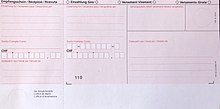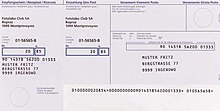Payment slip (Switzerland)
In Switzerland , two different forms are used as a payment slip to deposit a sum of money in Swiss francs into an account or transfer it from your own account. The payment slip enables simple invoicing and quick booking of payment transactions.
Payment slips are available from all banks and the Swiss PostFinance . Until June 2020, these are the payment slip with reference number (short: ISR or orange payment slip ) and the payment slip without reference number ( red payment slip ).
Since July 2020, the payment slip has been replaced by the “ QR-bill ”. This is an invoice with a printed QR code with digital and human-readable payment details.
use
In contrast to Germany and Austria , the payment slip is still used almost exclusively in Switzerland to settle claims, since (as of 2010) most Swiss people reject the direct debit procedure that is more common in Germany .
The proof of payment can also be entered in a receipt book (“yellow booklet”) when paying at the post office counter .
Payment slip with reference number (ISR)
The payment slip with reference number is issued by the biller ( creditor ) and sent to the debtor ( debtor ) in order to invoice open bills. The slip contains a reference number defined by the biller, which enables the payee to easily or automatically assign the payment process to his invoice accounting. The reference number contains a checksum so that typing errors can be recognized .
With ISR, a distinction is made between payment slips with a pre-printed amount and payment slips without an amount. Bills without a preprinted amount are also called ISR +. The ISR procedure is suitable for billers who have to create a large number of bills. By specifying a reference number, it is possible to automatically assign invoices with payments. The reference number is stored in a database with the other information on the claim. This data can then be compared with the payments made available by the executing bank and automatically booked out.
Inpayment slips can either be printed out with the invoice by the invoice issuer or sent to the debtor as a file, usually as a PDF . The debtor can transfer the claim either via online banking or as a bank order in paper form or pay in cash at any counter of the Swiss Post . The latter was the standard solution in Switzerland for a long time and was still widely used in 2010. PostFinance charges these counter payments to the recipient, who only receives a reduced amount. These postal charges will be increased from July 2020 after payment transactions have increasingly shifted to the Internet.
PostFinance AG and the banks provide users of ISR with daily incoming payments in several formats. There is also an excerpt in the form of a PDF document. Customers primarily request the data in the MT940 format . MT940 is a SWIFT standard ( Banking Communication Standard ). An account statement can also be requested in the ISO 20022 camt.053 or camt.054 format .
Payment slip without reference number
The payment slip without a reference number (also known as a “red payment slip”) is a payment slip that enables you to deposit money into your own or someone else's account or transfer it from your own account. Instead of a reference number, any text can be entered in the "Payment purpose" field. The payment slip is often scanned in and sent to the payee so that he can evaluate the "purpose of payment" field himself.
history
Green payment slips were used from 1906 to 1986. In 1986 the post office and banks issued a joint green payment slip. The red payment slip has been used since 1998. It could be scanned and replaced the green payment slip.
In 1971, the postal, telephone and telegraph companies (PTT) introduced the "Payment slip with reference number procedure" (VESR) with a blue payment slip. This “pioneering achievement” made it possible for the first time to process payments fully automatically. The service has been called ESR since 1996.
As part of the creation of the uniform euro payments area SEPA , the ISR procedure will be replaced by a procedure based on the ISO 20022 standard . This QR-bill uses the data code EPC QR code and has been gradually replacing the various payment slips since June 30, 2020.
Individual evidence
- ↑ Handbook ISR of PostFinance AG (PDF), accessed on January 29, 2017.
- ↑ a b Direct debit: The unloved payment method , contribution from May 5, 2010 of the show Kassensturz of the Swiss radio and television .
- ↑ Domestic payment transactions , PostFinance AG, accessed on December 12, 2019
- ↑ Payments at the post office counter are becoming more expensive. In: bluewin .ch. December 12, 2019, accessed December 12, 2019 .
- ↑ Manual, page 10 ( Memento of the original from January 28, 2017 in the Internet Archive ) Info: The archive link was inserted automatically and has not yet been checked. Please check the original and archive link according to the instructions and then remove this notice. (PDF).
- ↑ Kreissparkasse Köln Format description MT 940 (SWIFT).
- ↑ postfinance.ch ( Memento of the original from January 29, 2017 in the Internet Archive ) Info: The archive link was inserted automatically and has not yet been checked. Please check the original and archive link according to the instructions and then remove this notice. (PDF) Conversion of electronic account documents to ISO 20022.
- ↑ six-interbank-clearing.com (PDF) ISO 20022 Cash Management Swiss Implementation Guidelines for customer-bank messages (reports).
- ↑ Jürg Müller: Eight answers to the new payment slip . In: Neue Zürcher Zeitung . May 8, 2017 ( nzz.ch ).
- ↑ The history of PostFinance. Retrieved June 3, 2019 .
- ↑ QR-bill. In: six-group.com . Retrieved December 24, 2018 .




